The best varieties of pumpkin for open ground with photos and descriptions
Pumpkin has been considered a tasty and healthy product since ancient times. The crop is valued for its large fruits and sweet taste. Pumpkin is not picky when it comes to care; most varieties are cultivated in open ground. Orange beauties are especially good in the fall, when they are used to make pies, muffins, and sweet snacks. Different pumpkin varieties have different tastes, so when choosing a vegetable, gardeners recommend carefully studying the description of the most popular types.
The best pumpkin varieties
The quality and quantity of the harvest depends on the choice of variety. Some pumpkins show excellent results only in warm regions of the country; they do not affect other climatic conditions in any way.
Some pumpkins are grown for cooking; they have a sweet taste and crispy flesh. The result is a tasty and aromatic jam or jam. A number of varieties, on the contrary, cannot be stored for a long time, so it is better to consume them as soon as possible. Next, we’ll take a closer look at pumpkin varieties with photos and descriptions for open ground.
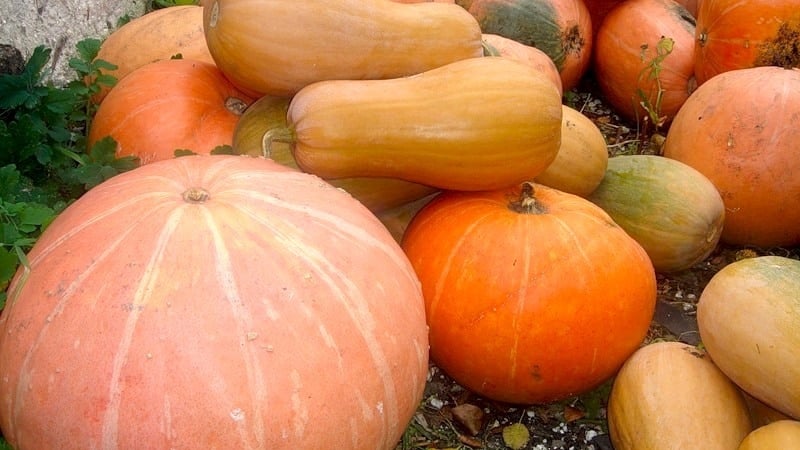
Large-fruited
The largest and heaviest vegetables are great for seasonal harvesting. The fruits are tasty, they contain few seeds. Gardeners especially love the varieties:
- Flashlight. Smooth vegetables of a delicate orange color ripen in 3-3.5 months from the moment of planting. The shape is round, with weak ribbing. The weight of the fetus is from 5 to 6 kg. The pulp has a yellow tint, is very juicy and tasty. Grow in sunny and spacious beds. Immunity to diseases is average; at times, the crop is infected with fungi and viruses.The Lantern variety is actively used in the kitchen in the preparation of healthy juices, soups, and purees.
- Russian porridge. The mid-season variety produces the first harvest 4 months after planting. The fruits weigh about 7 kg, their rind is hard and thick. The vegetable is suitable for long-term storage and does not lose its taste and beneficial qualities for a long time. The pulp is yellow-orange, aromatic. The product is consumed both fresh and after heat treatment. Vegetables are baked in the oven or boiled. To get a rich harvest, farmers advise fertilizing the beds with liquid manure.
- Russian. The variety, unpretentious to grow, ripens in 2.5-3 months. Sweet vegetables have a bright orange color and faint ribbing. The shape is slightly elongated, round. The variety is high-yielding, but the collected fruits cannot be stored for a long time. Cooks use the culture to make jam and juice. Russian pumpkin rarely gets sick, however, for preventive purposes, the vegetable is periodically sprayed with a soap solution or Bordeaux mixture.
- Merchant's wife. In weight pumpkin reaches 10-13 kg. The color is light orange, there are cream spots. The pulp is bright, dense and juicy. There are many light beige seeds inside. Due to their thick peel, vegetables are stored for a long time and are easily transported over long distances. The seeds are used for baking, and the pulp is used to make syrups and sweet desserts. The merchant's wife responds well to feeding with mineral complexes.
- bbw. Mid-season variety. The weight of one pumpkin is 6-7 kg. The peel is creamy, the flesh is bright orange. The shape is flat-round, the surface is rough. The variety is universal in use, the pulp is tasty. To get a rich harvest, gardeners water the pumpkin once every 4 days with warm water.
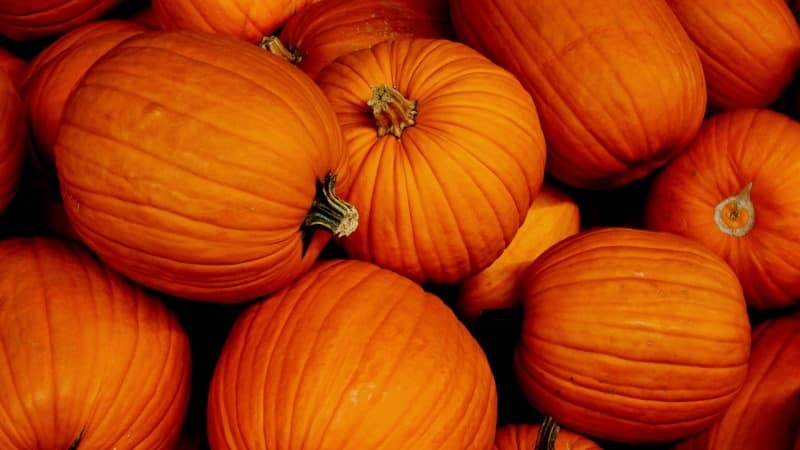
Muscat
Muscat varieties the sweetest.They are actively used for preparing side dishes, cereals, soups and sweet snacks. The juicy pulp adds piquancy to ordinary dishes.
The most delicious muscat varieties:
- Tsukatnaya belongs to the mid-late variety, summer residents harvest after 3 months. Average weight is 5 kg, the pulp is sugary and juicy. The color is light cream, the shape is slightly flattened. The variety is perfectly stored and transported.

- Nut, or Butternut. One variety has several names. The pear-shaped fruit ripens in 3 months. The color is light yellow, the flesh is orange. The smell is aromatic, the taste is nutmeg, with nutty notes. Pumpkin is consumed fresh or after heat treatment. The fruits are usually picked before they are fully ripe. Nut ripens at room temperature.
- Marble. An interesting variety has a gray-green color and bright yellow flesh. The harvest is harvested after 4 months. The weight of the fetus varies from 6 to 10 kg. Pumpkin is resistant to rotting and cracking and can be stored for a long time. The vegetable is added to milk porridges and dried for the winter.
- Vitamin. Large ribbed pumpkins weigh up to 5 kg. The color is bright orange, the skin is thin. The variety is mid-season; the pumpkin is removed from the garden after 3.5 months from the moment of planting. Used to make biscuits and muffins.
Important! To obtain a rich harvest, pumpkin is planted in seedlings. To do this, 2 months before the intended planting in the ground, seedlings are prepared: sterile soil is placed in a clean container and grooves are made in it. Place 2-3 seeds in each and sprinkle soil on top. The seedlings are watered every 5 days with warm, settled water. After 2 weeks, fertilize with ash or liquid manure.
Die-hard
Vegetables are distinguished by the fact that, thanks to their thick peel, they are stored for a long time. The shelf life of some varieties is a whole year.
The best hard-bark varieties: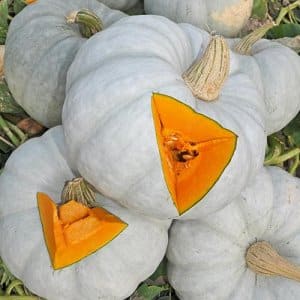
- Bun. Small round pumpkins reach a weight of 2.5-3 kg. Classic color, strong ribbing. Bun ripens in 3 months. The pulp is tasty and serves as an excellent basis for preparing healthy and dietary portioned dishes, such as salads or soups.
- Gymnosperm. The pumpkin has an unusual color: it is covered with light yellow and green stripes. Ripens in 4 months. Contains many seeds, which are used in the production of pumpkin seed oil and cosmetics.
- Acorn. Externally, pumpkins resemble large acorns. The surface is strongly ribbed and dark green in color. The pulp is honey-yellow, the taste is sweet. Hard-bark pumpkin can be stored for 2 to 4 months.
- Aport. Mid-season pumpkin produces a harvest in 3 months. The weight of the fruit in some cases reaches 6-7 kg. The surface is slightly rough, light orange. The taste is crispy, with honey and nutty notes.
Hybrid
Hybrids are characterized by high immunity to sudden climate changes and resistance to diseases and pests. It is best to grow hybrids in the north of the country.
Gardeners recommend pumpkin:
- Matilda f1. The hybrid came to Russia from Holland. The fruits ripen 3.5 months from the moment of planting. The pumpkins are small, 2-3 kg each. The shape is elongated, cylindrical. Color varies from orange to light pink. The hybrid has a sweet melon aroma and tasty pulp. Matilda can be stored for up to 4 months.
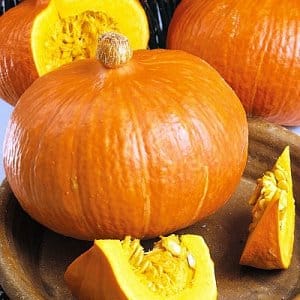 Hazelnut f1. Ripens in 3 months. The fruits are small, the surface is orange-red with strong ribbing. Weight – about 1.5 kg. The aroma is pleasant, but the taste is average. Hazelnuts are used in preparing baked and stewed dishes.
Hazelnut f1. Ripens in 3 months. The fruits are small, the surface is orange-red with strong ribbing. Weight – about 1.5 kg. The aroma is pleasant, but the taste is average. Hazelnuts are used in preparing baked and stewed dishes.- Barbara f1. It ripens in 3 months, delighting summer residents with a tasty and juicy harvest.The average weight of a pumpkin is about 4 kg. The pulp is used to make juice and puree.
- Candy f1. The mid-late vegetable is grown in open ground in any region of the country. The rounded fruits develop together. The weight of the fruit is about 3 kg, the color is orange. The hybrid serves as the basis for stuffing and will decorate any table.
Reference. A distinctive feature of all hybrids is that their seeds are not suitable for planting next year.
Decorative
This variety is gaining popularity every year. By using decorative varieties any plot of land acquires an interesting and attractive appearance.
What types of decorative pumpkins are there:
- Star or crown pumpkin. Externally, the fruits resemble a starfish or a crown. The shape is flattened, the diameter of the pumpkin reaches 15 cm. The color of the crop is white, orange, green, pink. Pumpkins develop quickly and without problems, so any gardener can get an original harvest.

- Turban gourd is a small fruit weighing 1 kg. Color and shape depend on many factors: planting location, weather, care. As a rule, turban-shaped pumpkins are used for crafts and design; they are eaten extremely rarely. The turban-shaped pumpkin has a kind of “cap” at the top, which gives the vegetable an even more original look.
- Pear-shaped. The small yellow fruits are very difficult to distinguish from pears. Some gardeners call vegetables light bulbs. The famous pear-shaped variety Kleine Bicolor has a two-color color: one half of the vegetable is yellow, the other has a green stripe.
- Tangerine. The diameter of the vegetable is only about 10 cm. As the name implies, in appearance the fruits resemble juicy tangerines. The ribbing is weakly expressed, the color is bright orange.Dried pumpkins look beautiful and make a wonderful decoration for any garden picnic or Halloween party.
- Warty. The surface of the vegetables is completely covered with small tubercles. There are single-color and two-color copies. They are used in decoration and interior design. There are pink, yellow and orange varieties based on color.
Crops and terrain
We have reviewed the most popular varieties and hybrids of pumpkins for open ground, and now we will find out which species feel best in Russian climatic conditions.
For the Moscow region
The Moscow region is famous for its fertile soil and warm climate. Thanks to these conditions, the harvest is as tasty and healthy as possible.
The best varieties for the Moscow region:
- Melon pumpkin - got its name due to its sweet taste. The first fruits are harvested 3.5 months after planting. The shape is round, the weight of one vegetable reaches 15-18 kg! The rind is orange, the flesh is juicy. Pumpkins have excellent shelf life and show stable yields from year to year.
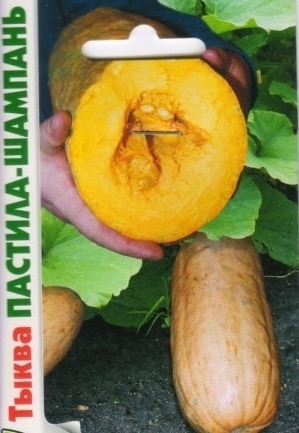
- Pastille Champagne looks like a melon. The shape is elongated and long, oval. The peel is pink, the rind is medium thick. Pumpkin weight is from 2 to 3 kg. It is universal in use; salads, juices, and stews are prepared from it.
- Sweet pie has a smooth, slightly ribbed surface. The color is classic orange, the aroma is sweet. The variety is stored for 2-3 months. Excellent for fresh consumption. The vegetables are crispy and tasty.
- Almond variety ripens in 3 months. Belongs to the hard-barked species, the color is rich orange. One vegetable weighs about 5 kg; thanks to its hard peel, it can be stored for a long time. The plant is cold-resistant and rarely gets sick.
- Big Moon ripens in 115 days. The fruits are very large, from 20 to 50 kg. The pulp is yellow-orange and tasty.Recommended for drying and drying.
For Siberia and the Urals
These regions do not have fertile soil or ideal growing weather. The Urals and Siberia are characterized by frequent rains, winds, and frosts. Therefore, varieties must have increased resistance to external factors:
- Honey. The early variety ripens in 3 months to avoid disease and show the best yield in a short time. Pumpkin got its name because of its sweet honey taste and aroma. Honey's weight is about 3-4 kg. Cooks use pumpkin pulp to make pies or cakes.

- Sweet tooth It is a round, ribbed green pumpkin. Weight varies from 1 to 5 kg. The pulp is bright, yellow. The taste is sweet and pleasant. Sweet candy is stored for 9 months and does not lose its taste and beneficial properties.
- Pearl has an elongated pear-shaped shape. Ripens in 2.5-3 months. The peel is thick, yellow in color with light green pigments. The weight of the pearl is about 4 kg. The variety is stored for a maximum of 6 months. Pearl pumpkin makes tasty and healthy additions to porridge or ice cream.
- Medical. Pumpkin pulp is ideal for proper and dietary nutrition. The color of the pumpkin is gray, the weight of the vegetable is 2-3 kg. The aroma is pleasant, the flesh is medium sweet. The medicinal variety is stored for six months.
Conclusion
Pumpkin is valued not only in Russia, but also in Ukraine and Belarus, European and Asian countries. The sugar in pumpkin does its job: the vegetable grows tasty and sweet. The product serves as the basis for preparing many dishes; it is actively used in folk medicine and even cosmetology.
The choice of variety depends on the growing region, soil conditions and microclimate.
I want to grow pumpkin for seeds on large hectares